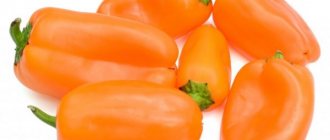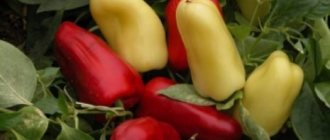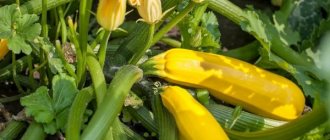The early-ripening and high-yielding pepper variety Siberian Prince is very popular in regions with cold climates. The Siberian Prince pepper is small in size, but has a good marketable appearance. The plant has undemanding care that even a novice gardener can handle.
Characteristics of the variety
| Options | Characteristic |
| Variety | Siberian prince |
| Description of fruits | Cone-shaped fruits with glossy skin. When unripe, the fruits are yellow-green and turn red as they ripen. Each fruit contains 3-4 chambers. |
| Pepper mass | 90 - 140 gr. |
| Color | After full ripening, the fruits acquire a rich red color. |
| Form | Cone-shaped fruits |
| Pepper size | Pepper length 16-20 cm |
| Wall thickness | 4.5 -5 mm |
| Taste of the fruit | The pulp is juicy and sweet |
| Productivity | Belongs to high-yielding varieties; from 1 m2 you can harvest up to 5 kg |
| Maturation speed | After the first shoots appear, the crop ripens within 105-110 days |
| Bush height | Bush height 70 -100 cm |
| Pollination type | Self-pollinating |
| Nestedness | 3-4 nest |
| Type of ovary formation | To form ovaries, it is necessary to carry out formative pruning |
| Transportability and keeping quality | The fruits are well stored without loss of taste characteristics, suitable for long-distance transportation |
| Resistance to adverse conditions | High |
| Resistance to diseases and pests | Has immunity to a large number of diseases. |
| Should I dive? | In order not to pick the seedlings, the seeds should initially be planted in separate containers |
| Recommended growing regions | Northern and central regions |
| Year of inclusion in the State Register of the Russian Federation | 2006 |
| Originator | Developed by specialists from the Scientific Center for Vegetable Growing and AF Search |
Advantages and disadvantages of vegetables
Seed producers describe the taste as excellent. The aroma is moderate. The main culinary use of this variety of peppers is fresh salads. But they are also quite suitable for canning, freezing, dishes and snacks of various types.
List of positive qualities of pepper:
- Increased yields. The crop shows good productivity in small areas: both in the open air and in greenhouse structures or greenhouses.
- Compactness in the garden. Despite their high growth, varietal bushes are densely placed in the garden bed.
- Beautiful looking fruit. Decent product characteristics. The yield of quality peppers with proper agricultural technology is at least 97%.
List of disadvantages:
- the originator has geographically limited the planting of the variety;
- there is no official data on the plant’s immune defense;
- The keeping quality of ripe fruits is mediocre due to the thickness of the walls.
Description of the variety
Pepper Siberian Prince is an early ripening pepper, most often used for growing in open areas. The fruits ripen evenly and have good keeping quality. The bush can reach a height of up to 1 m, spreading is average. Therefore, during the fruiting period, the plant must be tied to supports. The leaves are small, slightly elongated, light green in color.
Cone-shaped fruits can reach up to 140 g. After full ripening, the fruit acquires a rich red hue. The peppercorns are the same size, the flesh is juicy with a pleasant aroma.
Pros and cons of the variety
| Advantages | Flaws _ |
| Universal application | Needs to be moisturized regularly |
| Fast maturation | Tall bush needs to be tied up |
| The fruits ripen at the same time | The bush must be pinched, otherwise the fruits may become smaller |
| High yield | |
| The pulp is juicy and sweet | |
| Pleasant aroma | |
| Tolerates sudden changes in temperature well |
Tips for growing the Siberian Prince variety
The Siberian Prince pepper variety is intended for cultivation in open ground or a greenhouse. Seedlings should be planted in a permanent place of growth in early June. In cold regions, when grown in open ground, seedlings must be covered with film. To ensure that the peppers ripen evenly, you need to garter them. For such purposes, synthetic thread is used.
According to reviews from gardeners, seedlings should be planted in an unheated greenhouse at the end of May. To increase productivity, the plant needs to be watered regularly and loosen the soil under the bushes.
When to sow Siberian Prince pepper for seedlings
Seeds for seedlings must be sown after February 20 and before mid-March. Before planting, the material is soaked in a light solution of potassium permanganate and planted in loose nutrient soil.
How many days does it take for Siberian Prince pepper seeds to germinate?
After sowing the seeds, it is necessary to maintain a suitable temperature. To obtain quick shoots, the temperature should be 25-28 °C. Under such conditions, the first shoots appear on the 6th day.
When and at what distance to plant the Siberian Prince variety in the ground; distance between bushes
The period for planting seedlings in the ground depends on the characteristics of the growing region. For the Moscow region, seedlings can be planted at the end of May. For the northern regions, bushes should be planted no earlier than the first days of June.
Since the variety is tall, it is necessary to garter it. Therefore, the distance between plants is at least 25 cm.
Ripening period
You can collect fruits from the bush 105-110 days after the sprouts appear. The pepper has time to ripen properly and retain its taste for a long period. You can eat fruits that are not fully ripened, but such a crop has a short shelf life
Watering
Among agrotechnical care tips, watering is of great importance. It is necessary to water the bushes after the top layer of soil dries out. Warm, settled water is used for irrigation. At least 1 liter of liquid is used for each adult plant. The procedure must be carried out after sunset.
In order for moisture to be better absorbed, the soil is carefully loosened before watering. The depth of loosening is no more than 6 cm. Otherwise, the roots may be damaged and the plant will die.
What and when to feed
Fertilizing pepper increases yield. It is necessary to feed the crop according to the following scheme:
- The first feeding is carried out 10 days after picking. For this purpose, nitrogen fertilizers are used to stimulate the growth of seedlings;
- the second feeding is carried out before the formation of the inflorescence. Potassium preparations should be used as fertilizer;
- The third feeding is carried out during the period of fruit ripening, complex fertilizers are used.
It is necessary to feed the plant only after watering. Otherwise, burns may appear on the roots, which will negatively affect the yield.
Is it necessary to pick the Siberian Prince pepper and form a bush?
Picking is a necessary procedure for obtaining strong seedlings. Seeds planted in a seedling container are planted after the formation of the third true leaf.
The procedure is carried out according to the following recommendations:
- the container with seedlings is watered with warm water and left for 2 hours;
- the cups must be treated with potassium permanganate and filled with the mixture of soil that was used for sowing the seeds;
- Using a wooden spatula, each plant is carefully transplanted into a new container;
- On the first day, the seedlings need to be shaded a little so that the sprouts can adapt to the new place of growth.
It is also recommended to form a bush. Formation begins after the bush reaches a height of 50 cm. The lower shoots are carefully removed. It is also necessary to shorten the side shoots slightly to increase the size of the fruit. If such actions are not carried out, the fruits will be small.
Diseases and pests
In order for the plant to be less susceptible to diseases, the seeds must be treated before planting. However, in some cases, pepper is affected by the following types of diseases:
- tobacco mosaic. The disease manifests itself in the form of uneven coloring of leaves. Gradually, the leaves become deformed and the fruits may rot. To eliminate the problem, it is necessary to treat the bushes with a preparation such as Rovral;
- blackleg. Most often, the problem occurs when growing seedlings in greenhouses. It appears as a darkening of the sprout in the soil area. The disease cannot be treated, the affected plant is disposed of, and the soil is treated with a solution of 1% copper sulfate.
Pests also often form on pepper bushes. Among the most common it is necessary to highlight:
- aphid. Small insects that feed on plant sap. Most often the pest can be found on young shoots. To combat aphids, a soap solution is used. For 5 liters 100 grams of laundry soap. If there is a lot of pests, it is recommended to treat the bushes with preparations such as Strobi or Aktara;
- spider mite. The pest appears as small compactions on the leaves. If there are a large number of mites, you may notice a thin thread of cobwebs and curling of the leaves. To combat it, it is recommended to treat with Akarin.
Pepper leaves are also often damaged by slugs. If the number of pests is small, manual collection must be carried out. The presence of slugs in large numbers is eliminated by scattering ground red pepper between the bushes.
Landing
Seeds, pre-treated with a solution of potassium permanganate and then with a stimulant, are sown for seedlings two months before transplanting to the site. For seedlings, prepare common boxes or individual containers that will help avoid root injury when picking. The roots are fragile and easily damaged. You can sow seedlings in peat cups or tablets.
The soil is prepared from chernozem or loamy soil mixed in equal parts with sand and peat. Then it is calcined in an oven on a baking sheet for half an hour at a temperature of +110 degrees or poured with a dark pink manganese solution.
Seeds are sown in moist soil to a depth of 1 cm, covered with film and germinated in a warm place. When sowing in common boxes, they are picked in the cotyledon phase or 1-2 true leaves.
The seedlings are fertilized twice with an interval of 2 weeks, the first fertilizing is applied 14 days after picking. They use vermicompost or complex preparations - “Agricola”, “Solution”, etc.
10-14 days before transplanting, seedlings begin to be hardened off to the site, taking them outside for a short time every day.
They are placed in a garden bed according to a 70 by 40 pattern. Peppers should not be planted in areas where other nightshade crops had been growing for 3-4 years before.
Analogs
| Analogue | Similar characteristics |
| Martin | The culture is unpretentious to care and can be grown in all regions. Fruit ripening period is 110-115 days after emergence. The fruits are small, cone-shaped, and can reach up to 110 g. |
| Merchant | The description of the variety largely coincides with the Siberian Prince. The bushes are tall and can reach up to 85 cm, so they need a garter. The fruits are small, aromatic. |
| Belozerka and Isabella F1 | The variety has good characteristics and is suitable for growing in regions with unstable weather conditions. The fruits reach ripeness 110-115 days after emergence. The fruits are cone-shaped and uniform in size. |
Reviews
When describing their impressions of the variety, farmers leave the following reviews:
- The pepper is small, but very tasty and aromatic - Irina from Moscow.
- The crop bears fruit best in central Russia - summer resident Oleg.
- Pepper shows better yield than many advertised hybrids - gardener Tatyana.
- The variety is not prone to disease. The fruits are forming beautifully - gardener Oleg.
The Siberian Prince is a pepper who has proven that he is worthy of his big name. It is not afraid of negative weather changes and produces a bountiful and tasty harvest.











